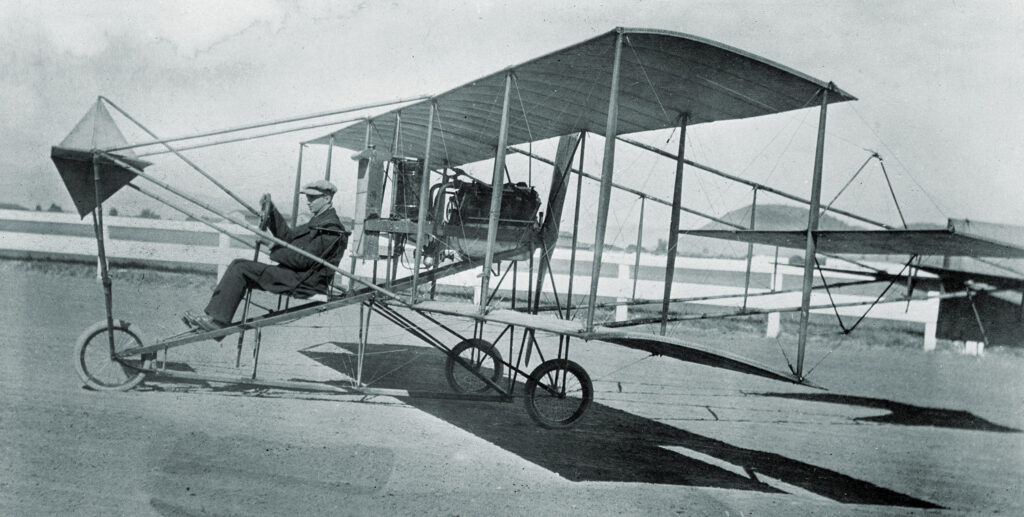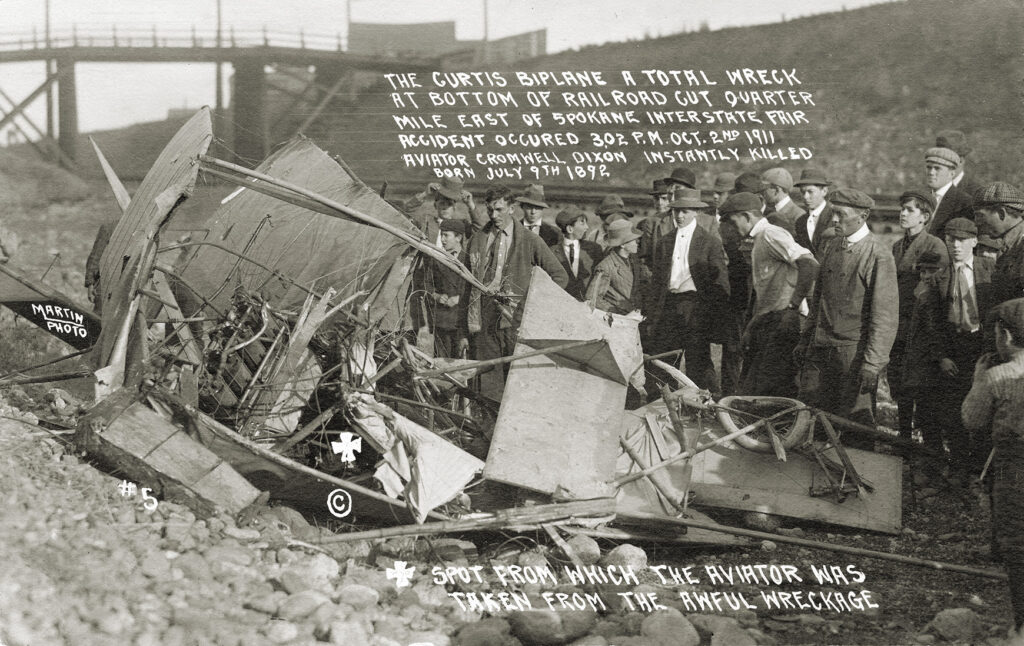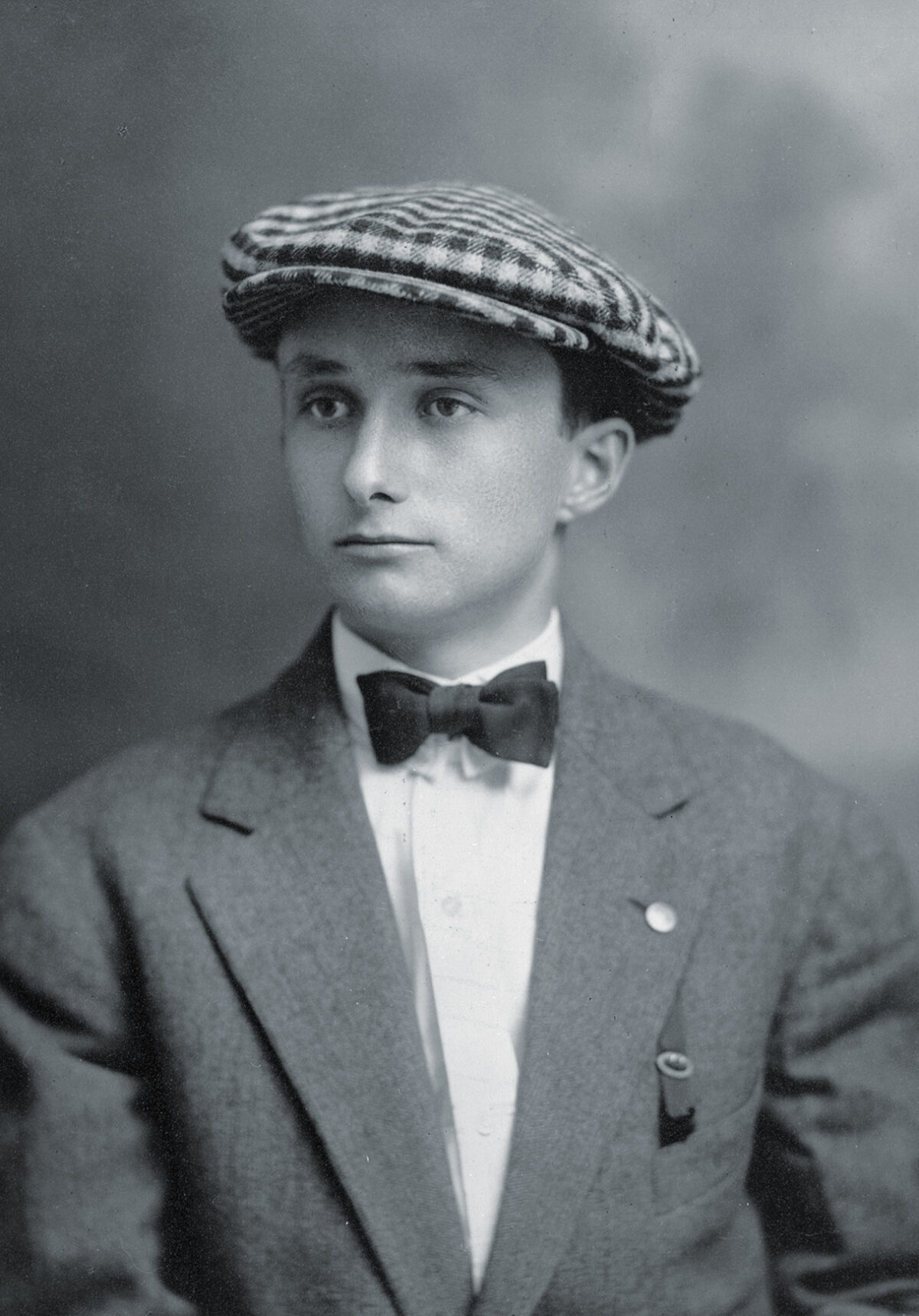“Here I go, here I go,” Cromwell Dixon shouted as the Curtiss biplane he had dubbed the Hummingbird started to plummet.
It was October 2, 1911, and Dixon was performing at the Spokane Interstate Fairgrounds in Washington State. At only 19 years old, he was the country’s youngest licensed pilot and one of the first superstars of the skies. A few days earlier, Dixon had made history in Montana and headlines across the country when he became the first person to fly over the Continental Divide. The “boy aeronaut” had been planning an even more ambitious flight: crossing the country in 30 days or less to win the $50,000 prize offered by publishing mogul William Randolph Hearst.
Flying was “his one ambition” said Annie Dixon, the mother he adored. He carried a picture of her as he traveled the country, performing for awed spectators who craned their heads skyward to see the miracle of flight for the first time.
Dixon was born on July 9, 1892, in San Francisco. His father died soon after, and the pregnant, widowed Annie Dixon moved her growing family to Columbus, Ohio, where she scratched out a living by sewing and renting rooms to students from Ohio State University.

There didn’t seem to be anything the young, gifted Cromwell Dixon couldn’t do, and do well. As a pre-teen, he was adept at taking apart and reassembling clocks, cameras and toy boats, improvising improvements for the mechanical devices. When he was 10, he built a rollercoaster for the neighborhood kids to ride, and a motorcycle the following year. “Aside from his powers as an inventor, Cromwell is an all around athlete, and not only has a gym in the house, but a basket ball team which plays in his barn loft,” wrote The Columbus Dispatch in 1906.
After watching a dirigible exhibition, Dixon became obsessed with flying and began working on his homemade “sky-cycle,” a pedal-powered dirigible. On June 9, 1907, the 14-year-old made an hour-long flight “in the presence of more than 500 people at the Columbus Driving Park [racetrack], his elevations ranging from 50 to 200 feet,” according to The Cincinnati Enquirer.
Dixon barely averted disaster that July 4 in Wellston, Ohio. As he ascended aboard his sky-cycle, “he was brushed from the airship by the top of a large tree and fell 80 feet to the ground,” reported the Times Recorder of Zanesville, Ohio. “The branches broke the force of his fall and he was unhurt.” Dixon later added an engine to his sky-cycle and the teen toured the country, thrilling crowds with his youth and flying prowess.
As the success—and growing rivalry—of the Wright brothers and Glenn Curtiss heated up, Dixon became determined to make the leap from dirigibles to airplanes. He earned license #43 from the Aero Club of America on August 6, 1911. Flying a Curtiss aircraft during his test flights at the Long Island aerodrome, Dixon landed within “five feet of the mark set for him, while on the other he came within eight feet of the line,” according to the Brooklyn Eagle.
The heyday of barnstorming and the era of those daring young men in their flying machines was still a decade away, but the Wright brothers and Curtiss had both formed flying exhibition teams in 1910 to promote their airplanes. Dixon joined the Curtiss team soon after earning his wings and began participating in exhibitions around the country.
Crashes were all too common for these pioneers, who flew machines of varying degrees of airworthiness in often-dangerous conditions—wind being a special enemy of the unstable aircraft—to meet the demands of their contracts. On August 28, 1911, in Kenosha, Wisconsin, Dixon suffered some minor injuries when the wheels of his aircraft hit a ditch and flipped over as he landed.

Dixon arrived in Helena for the Montana State Fair in late September 1911 in what the city’s Independent-Record called less-than-ideal conditions, with “a stiff breeze blowing from the west.” A better-known, more experienced pilot had been promised by the Curtiss manager, and local officials weren’t exactly thrilled with this “inexperienced youngster.” Dixon decided to prove the skeptics wrong on September 30 by setting off to cross the Continental Divide. He took off at 2:08 p.m., carrying a letter from Montana governor Edwin Norris addressed to the residents of Blossburg, Dixon’s intended destination. Little is known about this first high-altitude crossing of the Rockies, other than that Dixon arrived in Blossburg at 2:34 p.m. after about a 15-mile flight. “Not since the days when man invaded the domain of the birds and made possible the conquest of the air has a human being flown across the Rocky mountains,” read the governor’s poetic letter. “This seemingly impossible task has at last been accomplished, the backbone of the continent has been crossed.”
On his return flight, Dixon battled treacherous winds that made it difficult for him to gain altitude as he approached the Mullan Pass, which has an elevation of 6,200 feet. After what Spokane, Washington’s Spokesman-Review called “considerable tacking and veering,” he reached 7,000 feet and cleared the pass.
Dixon received a prize of $10,000 for his feat and began plans for the transcontinental flight. He hoped to depart on October 10 from Portland, Oregon, with a special train from the Great Northern Railway accompanying him across the country. But first, Dixon was scheduled to fly at the Spokane Interstate fairgrounds. (For more about the competition for the $50,000 Hearst prize, see “The Many Crashes of Cal Rodgers” in the Winter 2023 issue.)
Dixon took off on his first Spokane flight on October 2. As he banked for a turn, a sudden gust of wind “caught the plane, already at an angle, and before the operator could recover himself he was plunged head first to the track,” reported the Tacoma Daily Ledger. “He was rushed to the hospital but nothing could be done to save him.”
A day or two later, the New York World interviewed Annie Dixon. “There was nothing but bravery in my boy,” she said. “His one aim was to become the greatest flyer and in spite of the dangers of his hazardous work he tried and tried until he was successful.”






